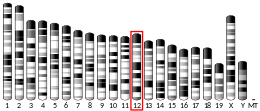KCNK13
Potassium channel, subfamily K, member 13, also known as KCNK13 is a human gene. The protein encoded by this gene, K2P13.1 is a potassium channel containing two pore-forming P domains.[5][6]
See also
- Tandem pore domain potassium channel
References
- GRCh38: Ensembl release 89: ENSG00000152315 - Ensembl, May 2017
- GRCm38: Ensembl release 89: ENSMUSG00000045404 - Ensembl, May 2017
- "Human PubMed Reference:". National Center for Biotechnology Information, U.S. National Library of Medicine.
- "Mouse PubMed Reference:". National Center for Biotechnology Information, U.S. National Library of Medicine.
- Rajan S, Wischmeyer E, Karschin C, Preisig-Müller R, Grzeschik KH, Daut J, Karschin A, Derst C (March 2001). "THIK-1 and THIK-2, a novel subfamily of tandem pore domain K+ channels". J. Biol. Chem. 276 (10): 7302–11. doi:10.1074/jbc.M008985200. PMID 11060316.
- Goldstein SA, Bayliss DA, Kim D, Lesage F, Plant LD, Rajan S (December 2005). "International Union of Pharmacology. LV. Nomenclature and molecular relationships of two-P potassium channels". Pharmacol. Rev. 57 (4): 527–40. doi:10.1124/pr.57.4.12. PMID 16382106.
Further reading
- Strausberg RL, Feingold EA, Grouse LH, et al. (2002). "Generation and initial analysis of more than 15,000 full-length human and mouse cDNA sequences". Proc. Natl. Acad. Sci. U.S.A. 99 (26): 16899–903. doi:10.1073/pnas.242603899. PMC 139241. PMID 12477932.
- Fearon IM, Campanucci VA, Brown ST, et al. (2006). "Acute hypoxic regulation of recombinant THIK-1 stably expressed in HEK293 cells". Adv. Exp. Med. Biol. ADVANCES IN EXPERIMENTAL MEDICINE AND BIOLOGY. 580: 203–8, discussion 351–9. doi:10.1007/0-387-31311-7_31. ISBN 978-0-387-31310-8. PMID 16683720.
- Goldstein SA, Bockenhauer D, O'Kelly I, Zilberberg N (2001). "Potassium leak channels and the KCNK family of two-P-domain subunits". Nat. Rev. Neurosci. 2 (3): 175–84. doi:10.1038/35058574. PMID 11256078.
- Gerhard DS, Wagner L, Feingold EA, et al. (2004). "The Status, Quality, and Expansion of the NIH Full-Length cDNA Project: The Mammalian Gene Collection (MGC)". Genome Res. 14 (10B): 2121–7. doi:10.1101/gr.2596504. PMC 528928. PMID 15489334.
- Theilig F, Goranova I, Hirsch JR, et al. (2008). "Cellular localization of THIK-1 (K(2P)13.1) and THIK-2 (K(2P)12.1) K channels in the mammalian kidney". Cell. Physiol. Biochem. 21 (1–3): 63–74. doi:10.1159/000113748. PMID 18209473.
- Gierten J, Ficker E, Bloehs R, et al. (2008). "Regulation of two-pore-domain (K2P) potassium leak channels by the tyrosine kinase inhibitor genistein". Br. J. Pharmacol. 154 (8): 1680–90. doi:10.1038/bjp.2008.213. PMC 2518462. PMID 18516069.
External links
- KCNK13+protein,+human at the US National Library of Medicine Medical Subject Headings (MeSH)
This article is issued from Wikipedia. The text is licensed under Creative Commons - Attribution - Sharealike. Additional terms may apply for the media files.



